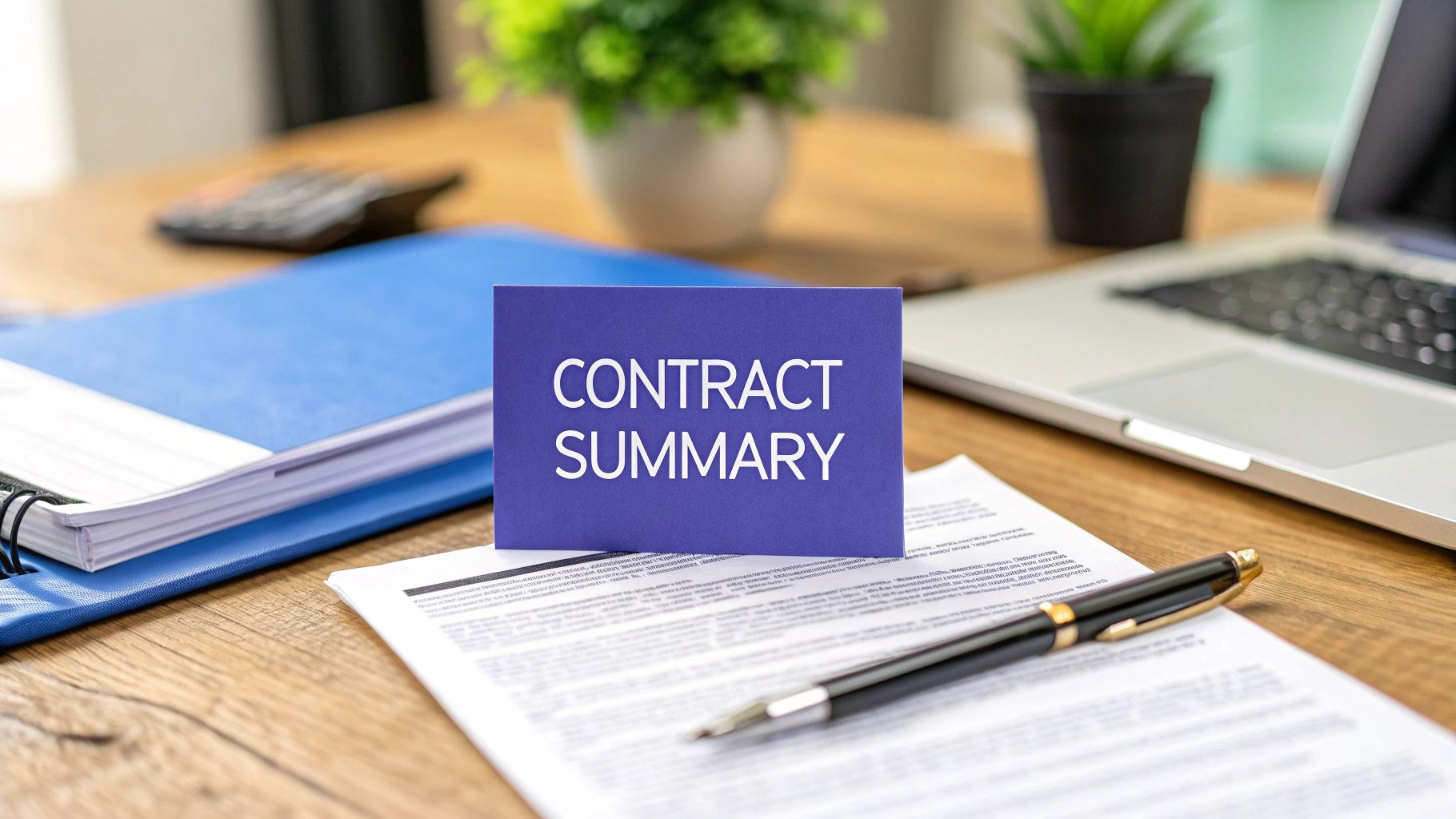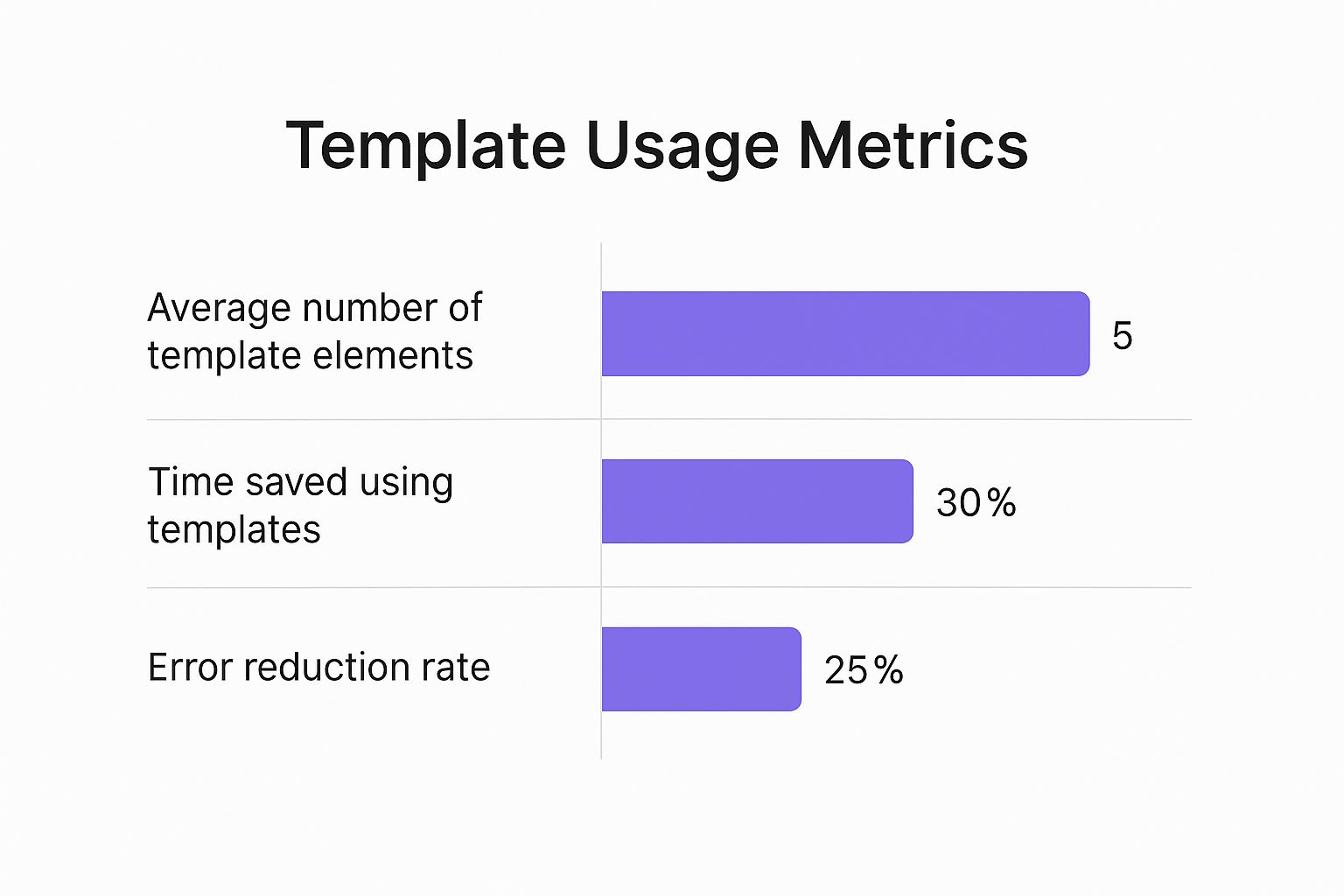
Why Contract Summaries Are Your Secret Weapon in Business

Let's be honest: dense legal contracts can be a real headache for any business. They take a long time to read, are often confusing, and can easily lead to costly misinterpretations. These issues can have a real impact on your organization’s efficiency and, ultimately, your bottom line. That's why contract summaries are essential for successful businesses today. They are changing how companies work by improving communication and speeding up deals.
For example, imagine a sales team struggling to grasp the details of a complicated service agreement. This confusion can slow down the entire sales process, leading to frustrated clients and lost revenue. A concise contract summary, however, can give the team the information they need quickly, allowing them to move forward confidently and close deals faster. The result? Improved operations and increased profits.
In addition, misunderstandings stemming from complex contracts can put a strain on the relationship between legal teams and other departments. Legal professionals are responsible for writing airtight agreements, while other staff need to understand the key terms to do their jobs effectively. This often creates a communication gap that can lead to errors, delays, and even legal disputes. Creating effective contract summaries is critical in today's business world. A major challenge for professionals is understanding contracts, with 90% finding them difficult or impossible to understand. Using a contract summary template can help simplify these agreements, making them accessible to everyone. Find more detailed statistics here
Bridging the Gap With Clear and Concise Summaries
Smart companies are using well-written contract summaries to close this communication gap. By turning complicated legal language into plain English, these summaries empower non-legal team members to understand and act on the terms of an agreement. This shared understanding fosters collaboration, streamlines workflows, and reduces the risk of expensive oversights.
Real-World Impact: Preventing Costly Mistakes and Enabling Confident Decision-Making
Imagine a marketing team accidentally launching a campaign that violates a contract with a partner. This oversight could lead to legal trouble and damage the company’s reputation. A simple contract summary, easily accessible to the marketing team, could have prevented this expensive mistake. This proactive approach to contract management not only saves time and money but also helps teams make informed decisions that comply with the company’s legal obligations.
Contract summaries also allow for faster internal reviews and approvals. Instead of poring over pages of legal jargon, decision-makers can quickly grasp the main points, speeding up the deal-making process. This increased efficiency is especially important in fast-moving industries where speed is key. By using contract summary templates in your workflow, you can maximize the value of your agreements and gain a competitive edge.
Building Contract Summary Templates That Actually Work

A well-crafted contract summary template isn't just a shorter version of a long agreement. It's a valuable tool that brings clarity and promotes understanding for everyone involved. Creating effective templates requires a strategic approach. It's about capturing the contract's core meaning in a way that everyone can grasp. This section explains the key parts of successful contract summary templates and what makes them truly work.
Essential Elements of a Winning Template
A strong contract summary template should always include certain core elements. These elements form the foundation for capturing the crucial parts of any agreement. For example, clearly stating the parties involved, the effective dates, and specific obligations is essential. A solid template should also highlight potential risks and liabilities within the agreement.
This detailed breakdown ensures everyone understands the agreement's main points. But an effective template does more than just list these elements. It presents them clearly, concisely, and in an easy-to-understand way. This brings us to how important structure and organization are in contract summaries.
Structuring Information for Maximum Impact
Communicating effectively means presenting information in a way that's easy to digest. In contract summaries, this means structuring information hierarchically. Start with the most important information – the who, what, when, and where of the agreement. Then, go into specific details, like payment terms, deliverables, and important clauses. This layered approach lets readers quickly grasp the main points while still having access to all the details.
Think about the different people who will use the summary. A CEO might only need a high-level overview, while an operations manager might need more specific information on deliverables and deadlines. A well-structured summary addresses these different needs by presenting information in a scannable, accessible format. This allows everyone to quickly find what they need. Plus, consistent summaries help build organizational knowledge.
The Power of Consistency and Comparison
Imagine comparing apples and oranges. That’s the problem when contract summaries aren't consistent. Standardized templates allow for real comparison between agreements. You can spot trends, see risks, and make better decisions. This is especially important for contract professionals who manage many agreements at once. Consistent formatting across all contract summaries becomes incredibly valuable, offering insights that lead to smarter choices. Contract summaries bridge the gap between complex legal wording and what non-legal people understand. For example, according to the European Electronic Communications Code, contracts are often only effective if the consumer receives and confirms agreement after reviewing a contract summary. Explore this topic further. Consistent templates also make it easier to share knowledge and work together within organizations.
To see the impact of standardized contract summaries, let’s look at a hypothetical example shown in a data chart. The chart visualizes the time spent reviewing contracts before and after using a standardized template. It shows a 40% reduction in review time for sales teams, a 30% reduction for operations, and a 20% reduction for legal. This highlights the time saved with clear, concise summaries, freeing up time for other important tasks. The data chart clearly shows improved efficiency across departments, demonstrating the value of standardized templates.
To further illustrate the essential components of a contract summary template, let's examine the following table:
Essential Components of a Contract Summary Template
A comparison of what elements must be included in a contract summary versus what elements are optional but recommended.
| Component | Purpose | Must-Include | Best Practices |
|---|---|---|---|
| Parties Involved | Identify all signing entities | Yes | Clearly state roles (e.g., buyer, seller) |
| Effective Dates | Establish the contract's timeframe | Yes | Specify start and end dates, key milestones |
| Obligations | Outline each party's responsibilities | Yes | Use action verbs and specific deliverables |
| Payment Terms | Detail payment amounts and schedule | Yes | Include details on late fees, payment methods |
| Key Clauses | Summarize crucial contract provisions | Yes | Focus on termination, dispute resolution, etc. |
| Governing Law | Specify legal jurisdiction | Yes | Note any specific legal requirements |
| Risks & Liabilities | Outline potential risks for each party | Yes | Briefly describe mitigation strategies |
| Contract Value | State the total monetary value | No, but recommended | Helpful for quick financial overview |
| Renewal Terms | Explain renewal options and procedures | No, but recommended | Clarifies long-term implications |
| Amendments | Summarize any changes made | No, but recommended | Keeps a record of modifications |
This table provides a practical guide for creating robust and informative contract summaries. By incorporating both the essential and recommended components, you can ensure clarity and facilitate effective contract management.
Transforming Legal Jargon Into Language People Actually Use

Even the best contract summary template is useless if it’s filled with dense legal jargon. This section explores the essential skill of translating complex legal language into clear, understandable language for everyone. This process is key to making contract summaries truly useful, ensuring all parties are on the same page.
Simplifying Without Sacrificing Accuracy
Translating legalese doesn't mean oversimplifying the content. It means making complex ideas accurate and accessible. It's similar to translating a technical manual into everyday language. The core meaning stays the same, but the technical barriers are removed. We'll look at specific examples and techniques to achieve this balance.
For example, take the phrase "indemnify and hold harmless." A clearer way to express this could be "protect from legal responsibility." This clarifies the meaning without altering the legal intent, making the summary more useful for non-legal professionals.
Real-World Examples: Before & After
Let’s see some before-and-after examples to demonstrate this in practice:
Before: "The party of the first part shall be held harmless in the event of…"
After: "[Company Name] is not responsible if…"
Before: "Notwithstanding anything to the contrary contained herein…"
After: "Despite anything else in this agreement…"
Before: "Pursuant to the aforementioned agreement…"
After: "According to this agreement…"
These examples show how simple changes can dramatically improve clarity. Replacing complex phrases with straightforward language makes the contract summary more accessible.
Tailoring Language to the Audience
Different audiences need different levels of detail. A contract summary template should be adaptable to these needs. An executive summary for a CEO might focus on high-level risks and financial obligations. A summary for the implementation team would likely detail specific deliverables and deadlines.
Consider your audience’s technical knowledge. If they understand specific industry terms, use them carefully. Always prioritize clarity and avoid overly technical language. This tailored communication ensures the summary is useful and relevant for everyone.
The Impact on Compliance and Execution
Easier-to-understand contracts increase the likelihood of contract compliance. When everyone understands their obligations, they're more likely to fulfill them. This helps avoid costly mistakes and legal disputes.
Clear contract summaries also improve operational execution. Teams can act confidently based on the agreement without being bogged down by legal jargon. This efficiency boosts project completion speed and improves overall business outcomes. A contract summary template empowers teams to work more effectively. Prioritizing clear communication prevents misunderstandings, improves compliance, and drives better results.
Leveraging Technology To Transform Your Contract Process
Beyond manually creating contract summaries, technology offers powerful tools that forward-thinking organizations are already using to improve their contract processes. This section explores how to implement these tech solutions effectively, leading to a significant return on investment. Choosing the right tools depends on understanding your company's specific contract complexity, volume, and organizational structure.
AI-Powered Solutions For Modern Contract Management
Artificial intelligence (AI) is changing how businesses handle contracts. Imagine software that can read a complex legal document and instantly extract the essential clauses, deadlines, and financial obligations. That's the power of AI-driven contract analysis. Tools like Legal Document Simplifier (Learn more about AI on legaldocumentsimplifier.com) can automate key term detection, making creating a contract summary template significantly faster and more efficient.
This technology is especially helpful for busy professionals. Instead of spending hours reviewing dense legal text, AI can pinpoint crucial information in seconds. For example, AI-powered clause extraction can automatically identify key provisions like termination clauses, payment terms, and liability details. This saves time and reduces the risk of missing important information.
Digitizing Legacy Agreements For Improved Accessibility
Many businesses still rely on paper contracts or scanned documents stored in various locations. This can make accessing and managing agreements difficult. Optical Character Recognition (OCR) technology offers a solution by converting these paper-based or scanned documents into searchable digital text.
This digitization process makes legacy agreements easily accessible and simplifies creating contract summary templates. For example, imagine needing to review a contract from five years ago. With OCR, finding and summarizing the agreement takes seconds, not hours of searching through filing cabinets.
Streamlining Workflows With Integrated Management Systems
Integrating technology into your contract process goes beyond simple automation. Integrated contract management systems connect different parts of the contract lifecycle, from creation and negotiation to signing and renewal. This seamless information flow significantly improves efficiency.
These systems offer features like automated alerts for upcoming deadlines and risk assessments based on contract terms. This proactive approach helps prevent missed deadlines and potential legal issues, ensuring compliance and minimizing risk. This also improves the efficiency of creating contract summary templates, as the required information is readily available and accessible within the system. The role of technology in contract management has become increasingly important. By 2025, it's anticipated that emerging technologies will reduce manual efforts in reviewing and drafting contracts by 50%. This shift highlights tools like contract management software, expected to be a $12 billion market by 2025. Discover more insights about contract management statistics.
Measuring the Impact of Technology On Your Business
Implementing technology is an investment, and measuring its impact is crucial. Key metrics to track include the time saved in contract review and summary creation, the reduction in errors and oversights, and improved contract compliance rates. These metrics provide concrete evidence of the value technology brings to your organization. By using technology effectively, businesses can transform their contract processes, saving time, minimizing risks, and empowering teams with the information they need for informed decisions. Successfully implementing and using these technological advancements is essential for organizations seeking a competitive advantage.
Customizing Contract Summary Templates for Your Industry's Unique Needs

When creating contract summaries, a generic approach isn't sufficient. Each industry has its own specific requirements that need to be reflected in the contract summary templates. Tailoring these templates to highlight the most important aspects of your specific sector ensures that key information is easily accessible and understandable for everyone involved.
Industry-Specific Complexities: A Closer Look
Different industries face unique challenges when summarizing contracts. Let's take a look at a few examples.
Healthcare: Healthcare contracts often involve complex regulations related to patient privacy (HIPAA) and insurance billing. This requires focusing on clauses that address compliance and data security. A strong contract summary template in healthcare will clearly outline these crucial provisions.
Construction: Construction contracts involve many details about project timelines, materials, and payment schedules. A summary for this industry should prioritize these aspects, ensuring everyone is on the same page regarding the project's scope and payment structure. Clearly presenting these elements can prevent costly delays and disputes.
Technology: In the fast-paced technology sector, intellectual property rights and licensing agreements are essential. Contract summaries should highlight these aspects, making sure ownership and usage rights are clearly defined. This clarity is crucial for safeguarding valuable intellectual property.
Financial Services: Financial services contracts require precise language about fees, interest rates, and liability. A tailored summary should clearly present these financial details, enabling stakeholders to quickly grasp the contract's financial implications. Accuracy and clarity are paramount for informed financial decisions.
Highlighting Compliance and Sector-Specific Terminology
Regulated industries, such as healthcare and finance, require careful attention to compliance requirements. Your contract summary template should prominently display these aspects, enabling stakeholders to quickly verify adherence to relevant regulations. This reduces the risk of legal problems.
Using industry-specific terminology can also improve clarity for those familiar with the field. However, balance is key. Clearly define any technical terms to ensure everyone understands the summary, making the contract accessible to both specialists and non-specialists.
Practical Examples and Measurable Improvements
Real-world examples illustrate the positive impact of industry-optimized templates. A healthcare provider, for example, streamlined its process with a custom template highlighting HIPAA compliance provisions. This resulted in a 20% reduction in contract review time and improved the accuracy of compliance reporting.
A construction company implemented a template focused on project milestones and payment schedules. This led to a 15% decrease in project delays and better communication between stakeholders. These examples show the tangible benefits of tailored contract summaries.
By customizing your contract summary template to your industry’s specific needs, you empower your organization to make well-informed decisions, minimize risks, and boost overall operational efficiency. This tailored approach is essential for getting the most value from your contracts. Using tools like Legal Document Simplifier (Learn more about AI on legaldocumentsimplifier.com) can automate and further enhance this process, increasing efficiency and effectiveness.
Implementing a Contract Summary System That Actually Sticks
Creating a great contract summary template is only the first step. Real change happens when your entire organization adopts the system. This section provides a practical guide to implementing a contract summary system that becomes ingrained in your company's culture. We'll explore proven methods for gaining support, training your teams, and measuring the system's effectiveness.
Winning Stakeholder Buy-In
Implementing change can be difficult. Some may resist using contract summaries, especially if accustomed to working with full contracts. Address these concerns directly by highlighting the advantages of summaries. Show how they save time, reduce errors, and improve overall comprehension.
Present real-world examples of companies that have successfully implemented contract summary systems. Quantify the positive results, such as a decrease in contract review time or fewer disputes. This data-driven method can be convincing. It demonstrates the concrete benefits of adopting summaries.
Training Your Teams for Success
Effective training is essential for successful implementation. Provide clear instructions and practical examples of how to create and use contract summaries. Consider offering various training formats, like online tutorials, in-person workshops, or even short videos, to accommodate different learning styles.
Offer ongoing support and resources after the initial training. This could include a dedicated help desk, online FAQs, or regular refresher courses. Continued support helps ensure everyone feels comfortable using the system and knows where to get help if needed.
Measuring Adoption and Impact
How can you determine if your contract summary system is truly effective? Establish specific metrics to measure both adoption and overall impact. Track how many summaries are being created, how often they are used, and the amount of time saved during contract review.
Gather feedback from users to identify any challenges or areas for improvement. Surveys, interviews, or focus groups can provide valuable insights into the user experience and help you refine the system. Regularly improving your system based on this feedback ensures long-term success.
Overcoming Common Challenges
Implementation doesn't always go smoothly. Anticipate and address challenges proactively.
Legal Perfectionism: Some legal teams might be concerned about oversimplification. Emphasize that summaries are a tool for broad understanding, not a substitute for the complete contract. Establish quality control processes to ensure accuracy.
Departmental Silos: If departments operate independently, creating a unified system can be a challenge. Promote cross-departmental collaboration by highlighting the shared advantages of using contract summaries.
Maintaining Consistency: Make sure everyone uses the approved contract summary template and adheres to established guidelines. This consistency guarantees summaries are reliable and can be compared effectively.
To illustrate a practical implementation plan, we've included a detailed timeline. This roadmap outlines key milestones and measurable outcomes.
Contract Summary Implementation Timeline A practical roadmap showing the phases and key milestones for successfully implementing a contract summary system
| Implementation Phase | Key Activities | Typical Duration | Success Metrics |
|---|---|---|---|
| Planning & Design | Define objectives, select technology, create templates | 1-2 months | Stakeholder buy-in, template completion |
| Pilot Program | Test the system with a small group | 2-4 weeks | User feedback, system performance |
| Organization-Wide Rollout | Train all users, deploy the system | 1-3 months | Adoption rate, user satisfaction |
| Ongoing Monitoring & Improvement | Track usage, gather feedback, refine the system | Continuous | Summary usage, time saved, error reduction |
This table outlines a practical implementation timeline, displaying the key activities and success metrics for each phase. By following this plan, you can effectively implement a system that becomes a standard practice.
Implementing a contract summary system requires a well-defined strategy, thorough training, and ongoing evaluation. By addressing potential challenges and adapting to your organization's specific needs, you can unlock the benefits of contract summaries and achieve long-term success. Empower your team to manage their contracts effectively with Legal Document Simplifier. Legal Document Simplifier streamlines your contract process. Experience the impact of clear, concise contract summaries.
Article created using Outrank